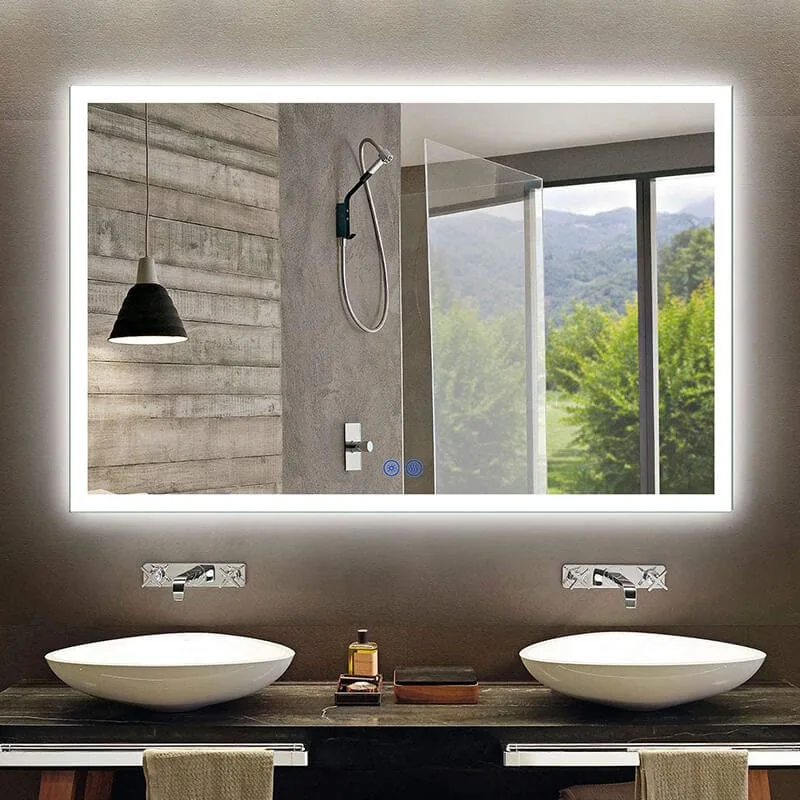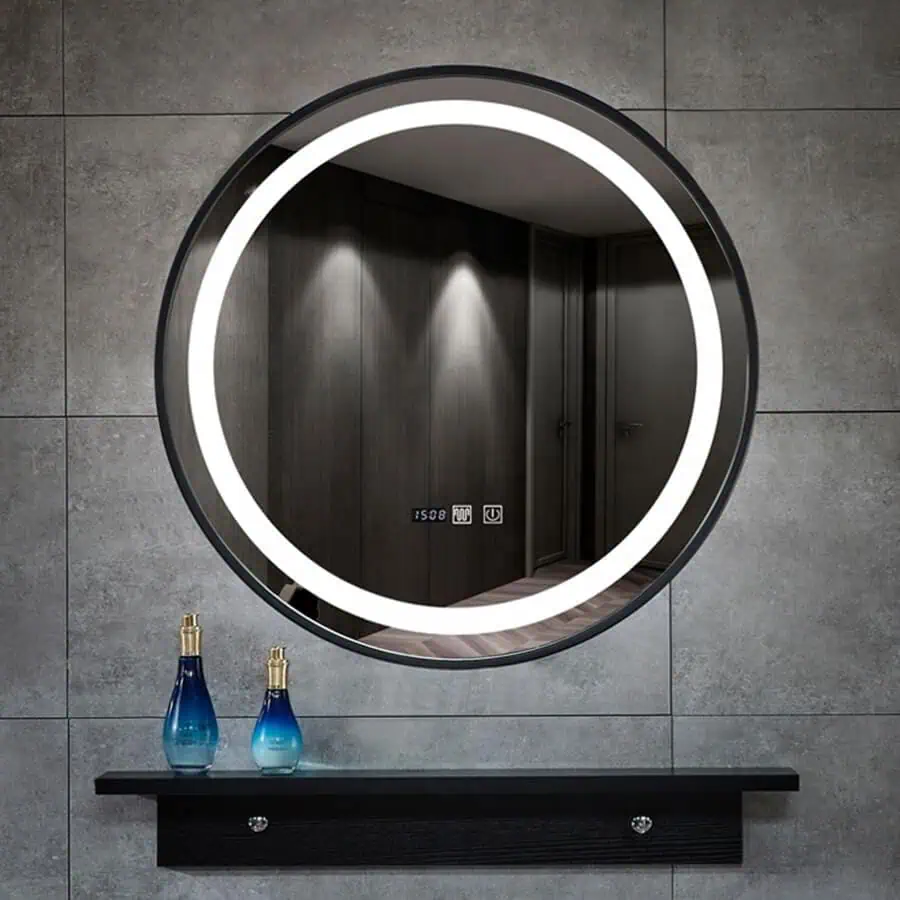LED bathroom mirrors are a must-have in modern homes and commercial spaces, improving light, functionality, and design. But as with anything, when they go wrong, they can be a pain to troubleshoot. Whether the issue is with the lights themselves, fog on the mirror, or something else, knowing how to fix the problem can save you time and headaches.
In this guide, we’ll discuss the 10 most common مرآة الحمام LED problems and provide practical solutions to each one, helping you maintain your mirror’s performance and longevity.
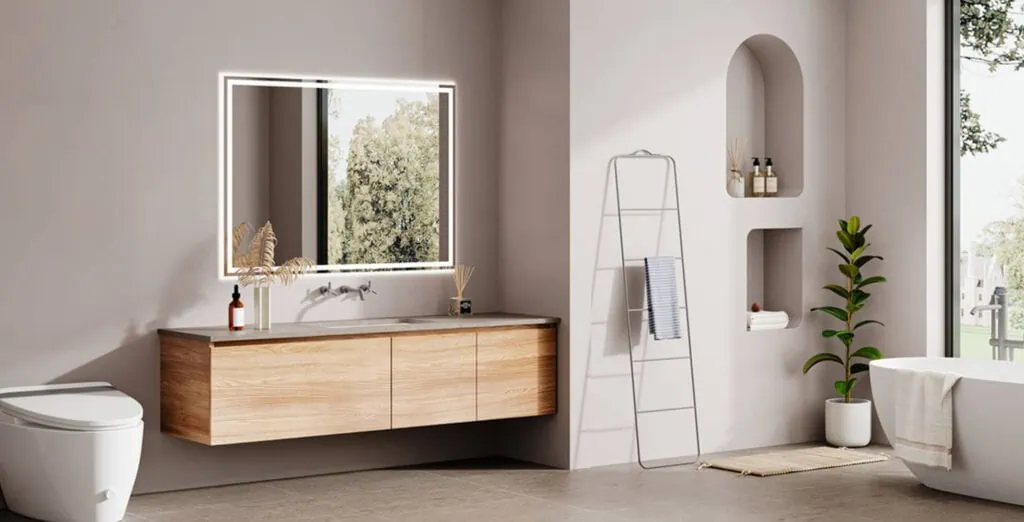
جدول المحتويات
تبديلWhy Is My LED Mirror Not Turning On?
The most frustrating problem you can have is when your LED mirror won’t turn on at all. This is usually due to a simple wiring issue or a major electrical bungle.
The most common problem is the power won’t connect to your LED mirror. This could be as simple as the cable not being plugged in all the way, or the cable could have been damaged or frayed. First, check to see if your mirror is plugged in.
Another potential source of the problem could be an issue with the wiring inside the mirror. The LED driver controls the flow of power to the LEDs. If there is an issue with the transformer, the LED driver or the wiring in the mirror, it’s best to check the warranty and contact the manufacturer for a fix or a new one.
Solution: Ensure the power connection is secure. Test the socket with another device to ensure that power is available. If the lamp still does not work, it may be necessary to call an electrician to check the wiring or to replace the LED driver or transformer.
In rare cases, a faulty wall switch or dimmer switch could be the problem. Some LED mirrors do not play well with certain types of dimmers, causing a failure in the power system. Be sure you are using the right switches designed for LED lighting. Also, check the circuit breaker to make sure the fuse has not been tripped due to an overload. If something on the circuit has tripped the breaker, resetting the breaker might fix the problem.
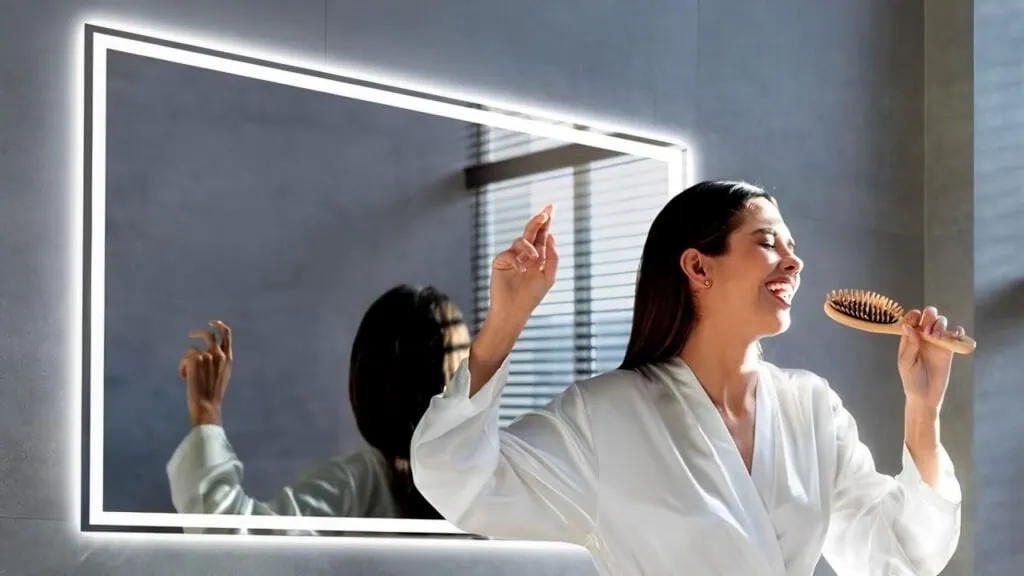
How to Fix Flickering LED Bathroom Mirrors?
Flickering lights is another common problem with LED bathroom mirrors. Besides being annoying, flickering could indicate a more serious electrical problem. Flickering happens when the power supply to the LED is inconsistent, which could be caused by loose wiring or a bad LED driver.
Possibilities include power fluctuations, a loose connection, or a defective LED driver. The driver is the device that converts standard electrical current into the low voltage that LEDs need to run properly. If the driver goes bad, it can send irregular power to the LEDs, causing them to flicker.
Solution: First, check for loose connections in the wiring. If your wiring is good and the connections are tight, the problem could be the LED driver. If you replace the LED driver, your LED lights should not flicker.
Related Content: Sometimes flickering can occur based on the quality of the LED components used in the mirror. Lower quality LED lights tend to flicker more often because they don’t handle fluctuations in power as well as higher quality lights. If your LED mirror continues to flicker even after replacing the driver, then you may need to consider replacing the entire LED strip with higher quality lighting. Also, you may want to consider installing a voltage stabilizer in your home if you experience frequent surges or drops in power. This will help provide a consistent power supply for your LED mirror.
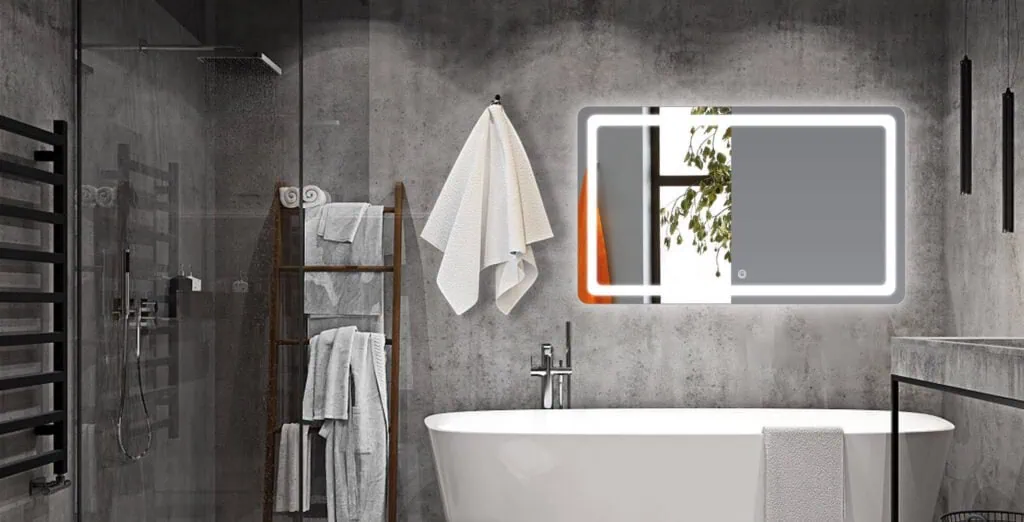
Why Is My LED Mirror Dimmer Than Usual?
Dim lighting is a common issue with LED bathroom mirrors, particularly as the lights get older. The brightness of LED bulbs can fade with time, which can be annoying if you depend on them for tasks like shaving, putting on makeup, or fixing your hair.
The most common reason you will experience dim lighting is aging LEDs or not enough power getting to them. Over time, the components inside the LEDs wear out and they don’t shine as brightly as they once did. Also, if the voltage from the power coming into the LEDs is low, then they don’t get enough power and they will glow dimly.
Solution: Check the power supply and make sure the mirror is getting the right voltage. If the power supply is good, then it’s probably time to replace the LED bulbs. In some mirrors, the LED strip is replaceable and all you need to do is swap them out. In other mirrors, it’s a more involved process.
Related Content: If your LEDs dim slowly over time, it’s probably just the natural decay rate of your LEDs. On average, an LED will last for 50,000 hours before you’ll need to replace it. If your LED mirror suddenly starts to dim, you may have a problem with the transformer or voltage regulator. You should check the manufacturer’s instructions to see if you can replace or upgrade your lighting components or see if you have any warranty coverage to help with repair or replacement costs.
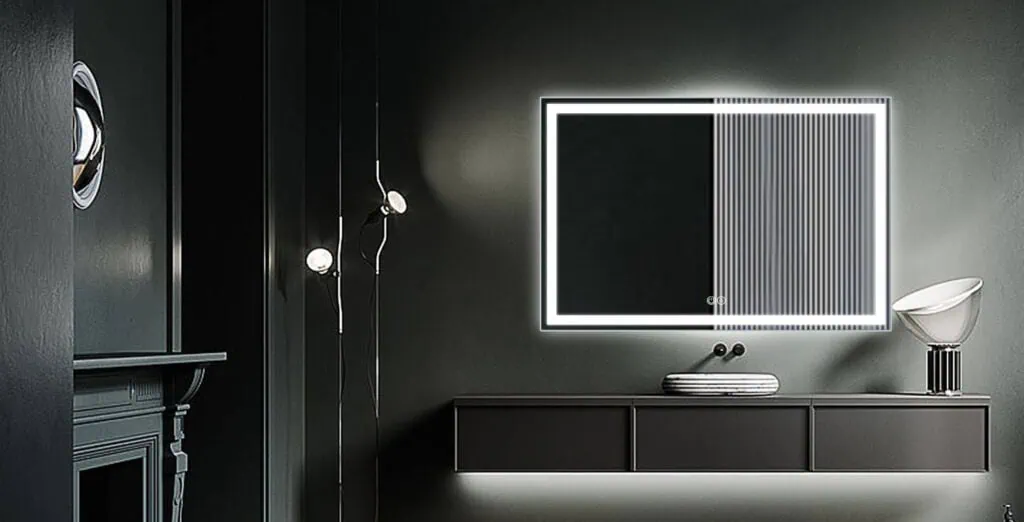
How to Resolve LED Mirror Fogging Issues?
One common issue with regular mirrors in a bathroom is fogging. LED bathroom mirrors, particularly those with demister pads, are designed to combat this problem, but it can still happen if the anti-fog feature isn’t turned on or isn’t working properly.
Fogging happens when the humidity in the bathroom collects on the mirror’s surface, especially after a hot shower. It’s a common issue in bathrooms that don’t have a lot of ventilation. It’s extremely frustrating if your LED mirror fogs up.
Solution: Many LED mirrors come with a defogging pad that prevents fogging by gently heating the surface of the mirror. Just make sure this feature is turned on. If your LED mirror doesn’t have a demister, consider adding one. In addition, take steps to improve the ventilation in your bathroom. That may involve nothing more than turning on the exhaust fan when you take a shower or bath.
Related Content: If you’re using a regular bathroom mirror without a defogging pad, you can apply an anti-fog spray to it to cut down on the condensation. Some people also recommend using vinegar and water when you clean the mirror as a way to prevent fogging. Finally, make sure your bathroom is vented properly by using a fan or keeping a window open to let the moisture escape.

What to Do if the Touch Sensor on My LED Mirror Stops Working?
Many modern LED bathroom mirrors have touch sensors. You touch the mirror to turn it on, touch it again to turn it off and hold your finger down to dim the lights. It’s a very convenient feature, but touch sensors can get dirty or stop working from an electrical standpoint.
Touch sensors can fail because of dirt, electrical interference, or internal wiring issues. The first thing to check if your touch sensor goes out is to make sure that the area is clean. Dirt or moisture can interfere with the sensor and make it unable to detect your touch.
Solution: If your sensor goes out, you can try to clean the area where the touch sensor is, and see if that solves the problem. If that doesn’t take care of it, try turning off the power to the mirror, and then turn it back on. If the sensor still doesn’t work, then you may need to contact the manufacturer about getting a replacement sensor or what to do next.

Why Is My LED Mirror Producing Noise?
While you generally don’t get a lot of noise from LED lights, a few people report hearing a buzzing or humming sound coming from the LED bathroom mirrors. Normally, this indicates a problem with the LED driver or electrical interference.
Buzzing or humming sounds are typically a result of a bad LED driver or electrical interference. The driver is the thing that regulates the electricity that goes to the LED lights and when it’s malfunctioning, it can cause it to vibrate or make noise.
Solution: The best way to fix this issue is to replace the LED driver. If the noise is coming from something rattling inside the mirror, try tightening all the screws and fittings.
Related Content: If the noise continues, it might be a case of electrical interference in your house. You might need to put it on a different circuit or try a power conditioner. Higher-quality LED drivers are less likely to produce noise, so spending more money in this case might help you.

How to Prevent Water Damage on LED Bathroom Mirrors?
Because they are in a bathroom, your LED mirror could run the risk of getting splashed with water, exposed to steam, or even dripped on with condensation. Over time, the moisture could cause the mirror to malfunction or even deteriorate.
Water damage occurs when moisture gets into the electrical components, or when moisture damages the frame of the mirror, which can cause rusting, short circuits, or permanent damage to the LED lights and sensors.
Solution: Make sure the mirror is sealed all the way around, especially where the LED mirror meets the wall. Also, don’t put the thing next to the sink or the bathtub, and make sure to wipe it down from time to time.
Related Content: If you live in an area with high humidity, consider using a dehumidifier in your bathroom. When it comes to humidity, the higher the IP rating, which stands for Ingress Protection, the better. A higher IP rating is the best when it comes to high-humidity areas because it keeps water and dust from getting inside the mirror. Look for a mirror with at least an IP54 rating, which means it’s splash-proof and okay to use in the bathroom.

Are LED Bathroom Mirrors Durable?
Durability is a primary concern for someone buying an مرآة الحمام LED, especially because it’s in your bathroom and you’re going to use it all the time.
Yes, LED mirrors are very durable and typically last 50,000 hours or more. Like any electronic device, how long it lasts depends on how well you take care of it and if it’s installed properly.
Solution: To ensure your LED mirror lasts as long as possible, install it in a location that minimizes exposure to water and steam. Regular maintenance, such as cleaning the mirror and inspecting the wiring, can also extend its lifespan.
Related Content: Make sure the mirror is made out of good materials. Make sure the frame is not going to rust. Make sure the LED lights are waterproof. If they meet the safety and durability standards for the industry, then you’re going to be okay.
Tips for Cleaning Your LED Bathroom Mirror
Cleaning an LED bathroom mirror requires a bit more care than cleaning a standard mirror, as you need to avoid damaging the LED lights and sensors.
To keep your LED mirror clean and in good working order, avoid using harsh chemicals or abrasive materials, as these can scratch the mirror or damage the electrical components. Instead, use a soft microfiber cloth and a mild cleaning solution to wipe down the mirror.
Solution: Spray your cleaning solution onto the cloth, not the mirror. This is especially important if you’re using a liquid cleaner because you don’t want the liquid to get into the LED components. Be careful around the edge of the mirror. Dust and grime can accumulate there. Because there are sensors along the edge of the mirror, you want to be as gentle as possible when you’re cleaning it. Exercise caution around the touch sensors and LED strips at the edge of the mirror.
Related Content: For a streak-free finish, consider using a vinegar-water solution or a specialized glass cleaner. Avoid ammonia-based products, as these can corrode the mirror’s surface or damage the LED components. Regular cleaning not only keeps your mirror looking great but also helps extend the life of the touch sensors and LED lights.
More details: How to Clean LED Mirrors Correctly? A Comprehensive Guide
Caring for Your LED Bathroom Mirror: Simple Maintenance Tips
LED bathroom mirrors are relatively low-maintenance, but it pays to take a few simple steps to keep them in good shape for years to come.
Regular maintenance consists of cleaning, inspecting for electrical issues, and replacing aging components. Dust can pile up on the mirror’s surface and sensors, which can impair their ability to work correctly.
Solution: Every so often, check the wiring and connections to make sure everything is working as it should. If you notice flickering or dimming lights, address the problem immediately to prevent additional troubles. Replacing aging LED strips or upgrading to newer components can also help improve performance and extend the life of your LED bathroom mirror.
Related Content: If your LED mirror is located in a high-humidity environment, consider adding a defogging pad or upgrading to a model that features built-in anti-fog technology. Check the mirror’s IP rating to make sure it is still adequately protected from moisture and dust. And don’t forget to pay attention to the weight and how the mirror is installed. Improper installation can lead to cracks or damage over time.

Summary
By addressing these common issues and following the maintenance tips, you can keep your LED bathroom mirror working correctly and looking great for years to come. Taking care of and fixing things as needed is the best way to get the most from your investment in this modern home accessory.

